Scottish Schools Adolescent Lifestyle and Substance Use Survey (SALSUS): smoking report 2018
Findings on smoking and e-cigarettes from the 2018 wave of the Scottish Schools Adolescent Lifestyle and Substance Use Survey (SALSUS).
This document is part of a collection
2 Prevalence and key trends
Summary of key changes over time
There were few changes in key measures between 2015 to 2018. Smoking prevalence has levelled-off since 2015, following a steady decline since 2004. The average number of cigarettes smoked in a week has remained similar among 15 year olds, for both boys and girls. The proportion of non-smokers who have tried e-cigarettes has increased among boys in both age groups. However, regular use of e-cigarettes has not changed since 2015.
Figure 2.1: Summary of trends in smoking between 2015 and 2018
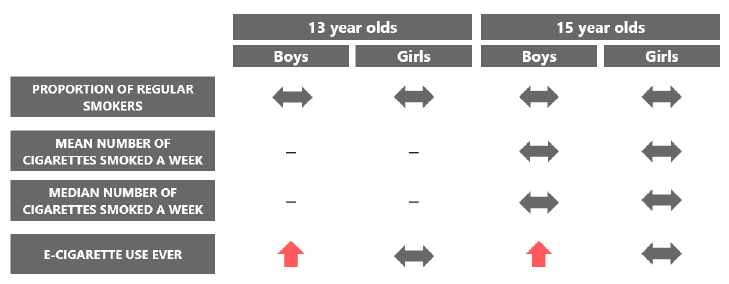
N.B. Data on the number of cigarettes smoked by 13 year old regular smokers has been left blank as the bases were too small to allow robust analysis.
Smoking prevalence
Pupils were classified as ‘regular smokers’ (defined as usually smoking at least one cigarette a week), ‘occasional smokers’ (currently smoking, but less than one cigarette a week) or ‘non-smokers’ (pupils who had never smoked or were not current smokers).
2018 Figures |
Almost all 13 year olds (97%) were non-smokers. 2% were regular smokers and 2% were occasional smokers. Smoking was more common among 15 year olds, but the prevalence was still low: 7% were regular smokers and 5% were occasional smokers (Figure 2.2). 87% of 13 year olds and 70% of 15 year olds reported never having smoked. |
|---|---|
Trends Over Time |
Smoking prevalence has decreased substantially over time, since 1996 among 15 year old boys and slightly later (since 2002-2004) among 15 year old girls and 13 year olds (Figure 2.3). However, this has levelled off in 2018, with no statistically significant changes this wave compared to 2015. |
Gender Differences |
Over the previous three decades or so, smoking prevalence tended to be somewhat higher among girls, but this is no longer true among 15 year olds in 2018. |
Figure 2.2: Smoking frequency, by age (2018)
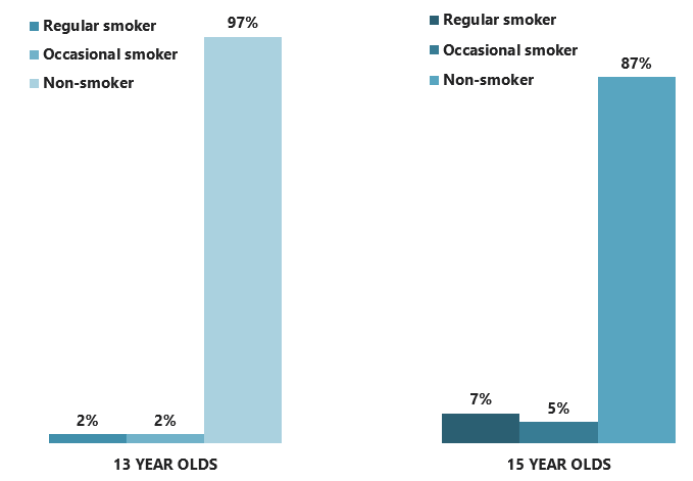
Base: all pupils, 13 year olds (12,282), 15 year olds (10,601)
Figure 2.3: Proportion of pupils who are regular smokers, by age and sex (1982-2018)
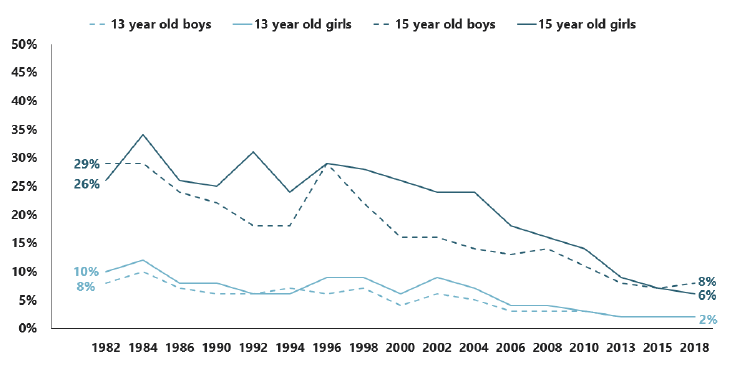
Base: all pupils (for full base sizes please see Appendix A)
Number of cigarettes smoked in the last week
2018 Figures and Gender Differences |
Among 15 year old regular smokers, the mean (average) number of cigarettes smoked in the last week was 50 for boys and 33 for girls. Because the mean can be affected by a relatively small number of pupils smoking a lot, it is also useful to look at the median number,[7] which was much lower: 28 for boys and 21 for girls (Figure 2.4). |
|---|---|
Trends Over Time |
There were no statistically significant differences in the mean or median number of cigarettes smoked among 15 year olds in 2018 compared to 2015. |
Figure 2.4: Mean and median number of cigarettes smoked in a week by 15 year old regular smokers, by sex (2018)
Q. How many cigarettes did you smoke on each day in the last 7 days, ending yesterday?
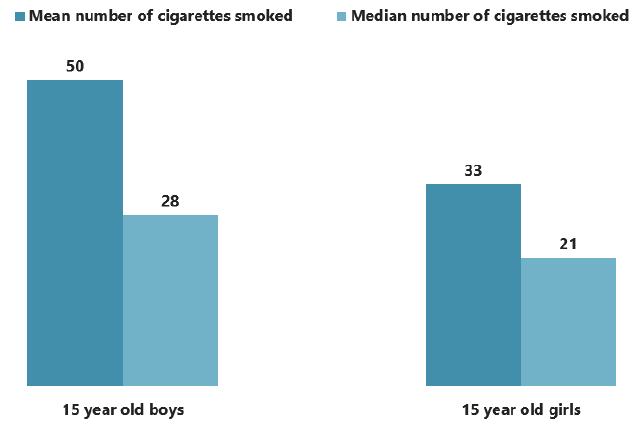
Base: 15 year old boys who are regular smokers (306), 15 year old girls who are regular smokers (245)
Length of time smoked
2018 Figures |
79% of 15 year old regular smokers had been smoking for 6 months or more. |
|---|---|
Trends Over Time |
The proportion of 15 year old regular smokers who have been smoking for 6 months or more has remained around 80% for almost two decades. The proportion of 15 year old girls smoking for 6 months or more has been fairly steady since 2015, however the proportion among 15 year old boys dipped in last wave but is now back in line with the overall trend (Figure 2.5). |
Gender Differences |
In 2018, the proportion of 15 year old girls and boys who had smoked for 6 months or more was similar. |
Figure 2.5 Proportion of 15 year old regular smokers who had been smoking for 6 months or more, by sex (1990-2018)
Q. How long is it since you started smoking at least one cigarette a week?
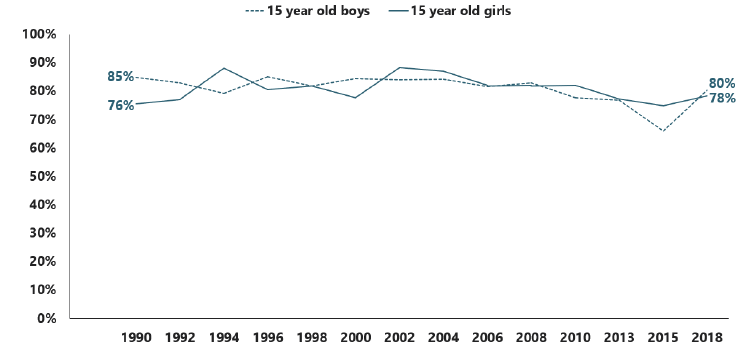
Base: 15 year old regular smokers (for full base sizes please see Appendix A)
Age first smoked
2018 Figures |
The mean age that 15 year olds (who had ever smoked) had first smoked a cigarette (‘even just a puff’) was 13 years and 5 months. |
|---|---|
Trends Over Time |
The age at which pupils first tried smoking has been gradually increasing since 2008 (Figure 2.6), although the rate of increase has slowed down between 2015 and 2018. |
Gender Differences |
15 year old girls were, on average, older than 15 year old boys when they first tried smoking (13 years and 8 months among girls, compared with 13 years and 2 months among boys). |
Figure 2.6 Mean age at which 15 year old pupils who had ever smoked, first tried a cigarette (2008-2018)[8]
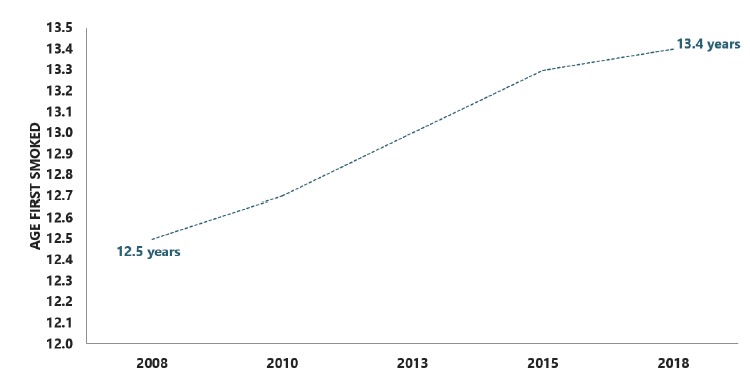
Base: 15 year olds who have ever smoked (for full base sizes please see Appendix A)
Perceived ease of giving up
2018 Figures |
Half (50%) of 15 year old regular smokers said they would find it ‘very’ or ‘fairly’ difficult to give up. Among 15 year olds who had smoked for more than a year, 69% said they would find it difficult to give up compared to 33% of 15 year olds who had been smoking for less than a year. |
|---|---|
Trends Over Time |
The proportion of regular smokers who say they would find it difficult to give up has remained very similar to 2015, following a general decline over time (since 2000 for boys and since 2004 for girls) (Figure 2.7). |
Gender Differences |
Since 2002, more girls than boys have said they would find it difficult to give up. |
Figure 2.7: Trends in proportion of 15 year old regular smokers who say they would find it ‘very difficult’ or ‘fairly difficult’ to give up, by sex (1992-2018)
Q. How easy or difficult would you find it to give up smoking altogether if you wanted to?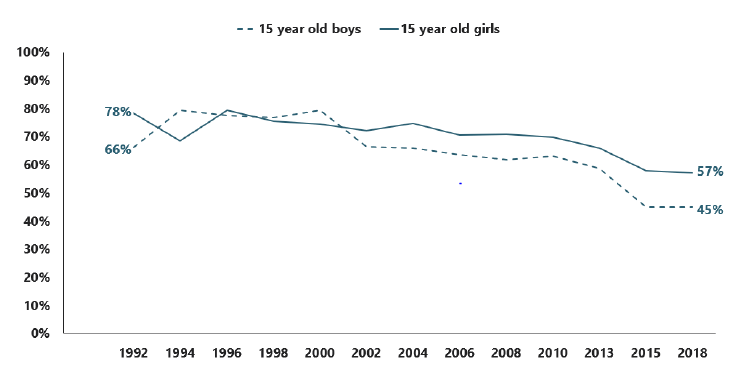
Base: 15 year old regular smokers (for full base sizes please see Appendix A)
Wanting to give up smoking
2018 Figures |
29% of 15 year old regular smokers said they want to give up smoking. A similar proportion (34%) said they would not like to give up. However, the biggest proportion (37%) said they did not know. |
|---|---|
Trends Over Time |
The proportion of 15 year old boys who smoke regularly but would like to give up has been decreasing since 2000 (Figure 2.8), although there was no statistically significant difference between 2015 and 2018. A similar but more variable decrease can be seen among girls from 2004 to 2015, although there was no statistically significant difference between 2015 and 2018. The trend broadly follows the decreasing trend in smoking prevalence. In other words, as the overall level of smoking decreases, fewer of those who do smoke want to give up. |
Gender Differences |
There were no gender differences in 2018. |
Figure 2.8: Trends in the proportion of 15 year old regular smokers who say they would like to give up, by sex (1992-2018)
Q. Would you like to give up smoking?
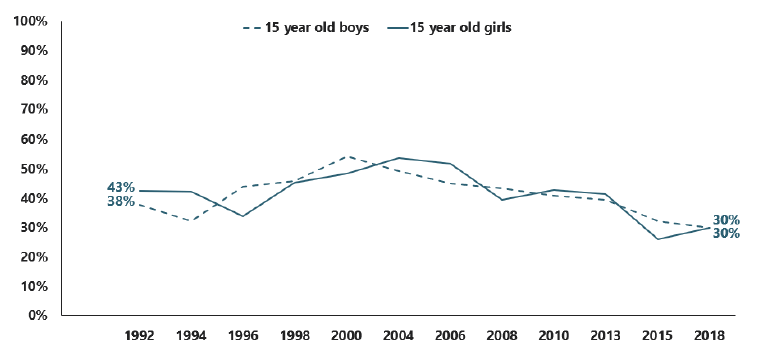
Base: 15 year old regular smokers (for full base sizes please see Appendix A)
Trying to give up smoking
2018 Figures |
Just over half of 15 year old regular smokers (53%) had tried to give up. |
|---|---|
Trends Over Time |
The proportion of 15 year old regular smokers who have tried to give up has decreased between 2008 and 2015, but remained steady from 2015 to 2018 (Figure 2.9). This is in line with the trend in the proportion who want to give up, and overall prevalence. As the overall prevalence of smoking decreases, fewer of those who do smoke have tried to give up. |
Gender Differences |
There were no statistically significant gender differences. |
Figure 2.9: Trends in the proportion of 15 year old regular smokers who have tried to give up, by sex (1992-2018)
Q. Have you ever tried to give up smoking?
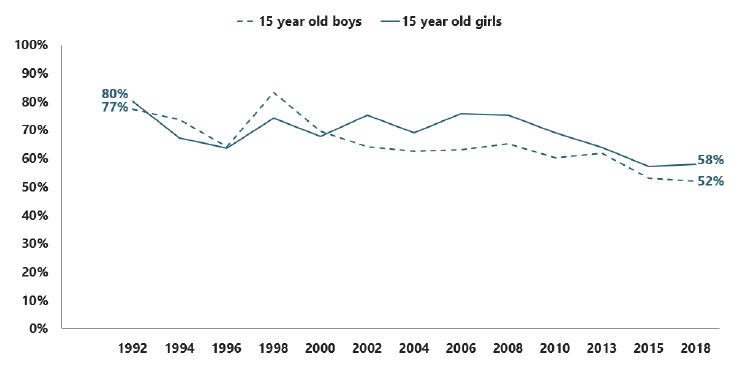
Base: 15 year old regular smokers (for full base sizes please see Appendix A)
E-cigarette use
2018 Figures |
17% of 13 year olds and 35% of 15 year olds have ever used an e-cigarette. However, only a small proportion used them regularly (defined as once a week or more): 2% of 13 year olds and 3% of 15 year olds. Smokers in both age groups were more likely than non-smokers to have ever used or regularly used an e-cigarette (Figures 2.10 and 2.11). |
|---|---|
Trends Over Time |
Between 2015 and 2018, the proportion of 13 year olds having tried e-cigarettes has slightly increased among non-smokers (13% to 15%) but not among regular or occasional smokers. This decreased among 15 year old regular smokers (91% to 84%) but increased among 15 year old non-smokers (24% to 28%). However, there were no significant changes in the proportion of frequent e-cigarette use (Figures 2.10 and 2.11). |
Gender Differences |
Boys were more likely than girls to have ever used e-cigarettes: 29% of boys had ever used e-cigarettes, compared with 22% of girls; and 3% of boys used e-cigarettes regularly, compared with 1% of girls. |
Figure 2.10: E-cigarette use among 13 year olds, by smoking status and year (2015-2018)
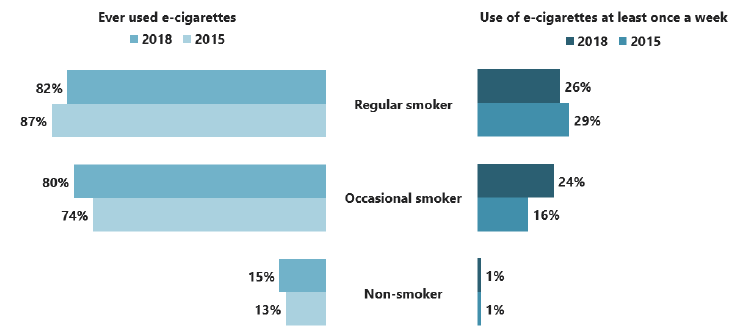
Base: 13 year old regular smokers (227), 13 year old occasional smokers (183), 13 year old non-smokers (11,572)
Figure 2.11: E-cigarette use among 15 year olds, by smoking status and year (2015-2018)
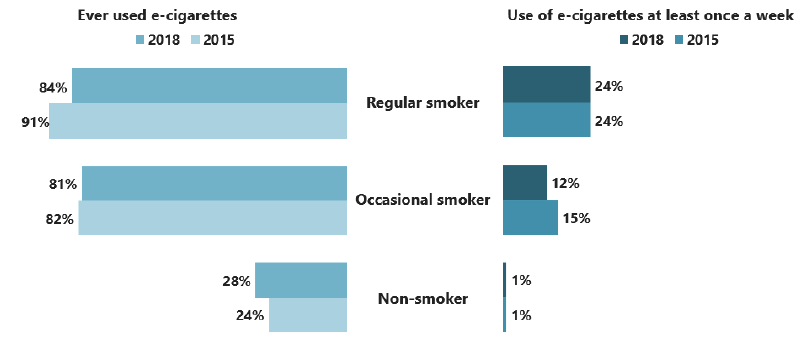
Base: 15 year old regular smokers (787) 15 year old occasional smokers (564), 15 year old non-smokers (9,039)
Contact
Email: salsus@gov.scot
There is a problem
Thanks for your feedback